
Vietnam Journal of Biotechnology 22(1): 79-89, 2024. DOI: 10.15625/vjbt-20641
79
IN SILICO EVALUATION OF HYPERICIN AND PSEUDOHYPERICIN AS
CANDIDATES FOR MONKEYPOX TREATMENT
Thai Ke Quan 1,, Huynh Phuoc 2, Hoang Ba Thanh Hai3, Nguyen Ba Hai4
1Faculty of Natural Science Education, Saigon University, 273 An Duong Vuong, Ward 3,
District 5, Ho Chi Minh City, Vietnam
2VNU HCMC University of Science, 227 Nguyen Van Cu, Ward 4 District 5, Ho Chi Minh
city, Vietnam
3Faculty of Agricultural Applied Biology, College of Food Industry, 101b Le Huu Trac, Son
Tra District, Da Nang City, Vietnam
4Faculty of Pharmacy, Binh Duong Medical College, 529 Le Hong Phong, Phu Hoa Ward,
Thu Dau Mot City, Binh Duong Province, Vietnam
To whom correspondence should be addressed. E-mail: tkquan@sgu.edu.vn
Received: 10.11.2023
Accepted: 25.02.2024
ABSTRACT
Monkeypox (Mpox) is a viral zoonotic and human-to-human disease with no specific drug
or treatment protocol targeting the monkeypox virus (MPXV). In the MPXV life cycle, viral
kinase phosphorylation plays a crucial role in early morphogenesis in the cytoplasm, making
inhibition of MPXV kinase a potential therapeutic approach for controlling Mpox.
Hypericum sampsonii contains several bioactive compounds, such as hypericin and
pseudohypericin, which are known for their antiviral properties. In this study, a
computational investigation of the physicochemical properties of hypericin and
pseudohypericin revealed drug-like characteristics. Pharmacokinetic predictions indicated
that hypericin and pseudohypericin are non-toxic to the central nervous system, hepatic
system, and cardiac system. Molecular docking results indicated a strong binding affinity of
hypericin/pseudohypericin with MPXV thymidylate kinase. As a result, these compounds
are being considered as potential Mpox control candidates.
Keywords: Monkeypox virus, Hypericum, Hypericum sampsonii, hypericin,
pseudohypericin, thymidylate kinase.
INTRODUCTION
Monkeypox (Mpox) is an infectious disease
caused by the Monkeypox virus (MPXV)
and capable of human-to-human
transmission (Riopelle et al., 2022). MPXV
is classified under the Orthopoxvirus genus
within the Poxviridae family, which also
includes Vaccinia, Cowpox, and Smallpox
viruses (Alkhalil et al., 2009). The first
confirmed case of MPXV infection was
recorded in 1970 in the Demographic
Republic of Congo (Breman et al., 1980). In
mid-2022, the World Health Organization

Thai Ke Quan et al.
80
(WHO) declared the resurgence of Mpox,
raising global concerns as numerous
countries reported multiple cases confirming
MPXV infections (Schnierle, 2022). By
January 2024, Mpox had accounted for over
93,000 confirmed cases and 179 deaths
across 117 countries, as reported by the
WHO. This underscores the substantial
threat Mpox poses to public health.
Currently, no specific antiviral treatment for
MPXV is available on the market (Kumari et
al., 2023). Therefore, developing novel
molecular compunds capable of controlling
MPXV is of pivotal significance in treating
Mpox.
The previous study identified the A48R
protein within the Orthopoxvirus genus as a
promising candidate for drug design
(Prichard, Kern, 2012). The A48R protein
acts as a thymidylate kinase (TMPK),
facilitating the phosphorylation of thymidine
5'-monophosphate to generate thymidine 5'-
diphosphate (TYD). The thymidylate kinase
protein of MPXV (MPXV-TMPK) is
identified as a novel target protein that lacks
a specific inhibitor (Pourhajibagher,
Bahador, 2023). As a result, the exploration
of new compounds capable of selectively
binding to effectively MPXV-TMPK has the
potential to control Mpox.
Hypericum sampsonii Hance, a member of
the Hypericaceae family, is recognized as a
medicinal plant in many countries (Sun et al.,
2023). It is predominantly found in Northern
Vietnam, Eastern Myanmar, Northeast India,
and China (Sun et al., 2023). Previous studies
have highlighted the diverse biological
properties of H. sampsonii, including anti-
inflammatory, antinociceptive, antioxidant
activities, antimicrobial as well as antiviral
effects (Sun et al., 2023; Xie et al., 2021). The
chemical composition of H. sampsonii
encompasses a range of metabolites, such as
polycyclic polyprenylated acylphloroglucinols,
benzophenones, flavonoids, xanthones,
naphthodianthrones, anthraquinones, and
aromatics (Sun et al., 2023; Xie et al., 2021).
Naphthodianthrones contain highly
biologically active substances, notably
hypericin and pseudohypericin (Hongyan et
al., 2002). Hypericin can be extracted from
flowers and fruits, while pseudohypericin is
predominantly found in the aerial parts of H.
sampsonii (Sun et al., 2023). The antiviral
properties of both compounds have been
established in numerous studies,
encompassing herpes simplex types 1 and 2,
and HIV-1 (Barnes et al., 2001; Zhang et al.,
2022). Hypericin is actively employed in the
development of drugs or intermediate
compounds for photodynamic therapy
(PDT) and photodynamic diagnosis (PDD)
(Jendželovská et al., 2016; Yuan et al.,
2023). Due to their ability to inhibit protein
kinases (Takahashi et al., 1989), hypericin
and pseudohypericin are the most promising
compounds for blocking MPXV-TMPK
activity.
MATERIALS AND METHODS
Building MPXV thymidylate kinase
protein and validation model
The amino acid sequence of MPXV-TMPK
was obtained from GenBank (Accession
number YP_010377155.1). The structure of
Vaccinia virus thymidylate kinase (PDB ID:
2V54) was used as the template for
constructing MPXV-TMPK using the
SWISS-MODEL (Waterhouse et al., 2018).
The homology protein model underwent
validation the through Structure Assessment
tool of the SWISS-MODEL server
(Waterhouse et al., 2018), ProSA
(Wiederstein, Sippl, 2007), and ERRAT
tools (Colovos, Yeates, 1993).

Vietnam Journal of Biotechnology 22(1): 79-89, 2024. DOI: 10.15625/vjbt-20641
81
Target protein preparation
MPXV-TMPK was prepared using the
Protein Preparation Wizard module within
the Maestro software. This preparation
involved assigning bond orders and
incorporating missing hydrogen atoms.
Subsequently, the orientations of hydrogen-
bonded groups were optimized, and the
overall structure was minimized using the
OPLS4 force field (Lu et al., 2021).
Ligands preparation
The chemical formulas of hypericin and
pseudohypericin were determined in a
previous study (Karioti, Bilia, 2010). The
three-dimensional (3D) structures of
hypericin and pseudohypericin were
constructed and optimized using the OPLS4
force field through the Ligprep module.
In silico prediction of physicochemical
and pharmacokinetics properties
The physicochemical and pharmacokinetic
properties of hypericin and pseudohypericin
were assessed using the QikProp module.
The physicochemical parameters included
molecular weight (MW), hydrogen-bond
acceptor atoms (HBA), hydrogen-bond
donor atoms (HBD), Octanol/water partition
coefficient (QPlogPo/w), and polar surface
area (PSA). Pharmacokinetic predictions for
the ligands encompassed Volume, Caco-2
cell permeability in nm/s (QPPCaco),
brain/blood partition coefficient (QPlogBB),
predicted IC50 value for blockage of HERG
K+ channels (QPlogHERG), predicted
aqueous solubility (QplogS) and human oral
absorption (%HOA). The pkCSM server
(Pires et al., 2015) was used to predict
AMES toxicity, hepatic toxicity, and skin
sensitisation of hypericin and
pseudohypericin.
Molecular docking analysis
Molecular docking utilized TYD in the
crystal structure as a template ligand to
identify active residues of MPXV-TMPK.
Autodock Vina version 1.2.5 (Eberhardt et
al., 2021) was employed to create complexes
of hypericin and pseudohypericin with
MPXV-TMPK. The dimensions of the grid
box were set as follows: a box size of 60 for
all coordinates centered at x = 9.176, y =
20.8, and z = 1.846. The ligand flexibility
(exhaustiveness) was set to 32, and 9 models
were generated. The model with the lowest
docking score, as predicted by Autodock
Vina, was selected as the most favored
conformation. The PRODIGY server
(Vangone et al., 2019) was used to estimate
the binding affinity of TYD, hypericin, and
pseudohypericin with MPXV-TMPK.
ChimeraX version 1.5 (Pettersen et al.,
2021) was used to illustrate the protein-
ligand complex. The Ligand Interaction
Diagram module of Maestro software
determined the interaction of ligands with
TMPK.

Thai Ke Quan et al.
82
Figure 1. TYD is bound into the active site of MPXV-TMPK. TYD of crystal structure was colored in
Cyan color and TYD redocked by Autodock Vina is present in Sand color.
Figure 2. MPXV-TMPK validation parameters. (A) Ramachandran plot from SA server showing
favored regions. The Z-score of MPXV-TMPK compared with similarly size protein by SA server (B)
and (C) ProSA server. (D) Local Quality Estimate per residue of MPXV-TMPK by SA server.
RESULTS AND DISCUSSION
MPXV-TMPK protein model validation
The Ramachandran plot analysis from the
Structure Assessment tool (Waterhouse et
al., 2018) revealed that MPXV-TMPK had
97.52% favored Ramachandran reagions
(Figure 2A). The Overall Quality scores
from ERRAT and SA servers were 97.4359
and 0.94 ± 0.06, respectively, indicating
high-quality protein and validating the
model’s legitimacy. Structural predictions
from SA and ProSA servers showed that
MPXV-TMPK aligns with proteins of

Vietnam Journal of Biotechnology 22(1): 79-89, 2024. DOI: 10.15625/vjbt-20641
83
similar sizes, with Z-scores < 1 (Figure 2B)
and -6.68 (Figure 2C), respectively. The
Predicted Local Quality Estimate from the
SA server demonstrated that all TMPK
residues scored above 0.8, confirming the
absence of unusual amino acids in the
structure. Therefore, the MPXV-TMPK
model was considered reasonable and
reliable as a target for hypericin and
pseudohypericin.
In silico Prediction of Physicochemical
and Pharmacokinetics Parameters
The primary objective of the
physicochemical and pharmacokinetic
investigation is to assess the drug-likeness of
hypericin and pseudohypericin. Qikprop
evaluation indicates that these compounds
fall within accepted values (Table 1). Both
compounds violated Lipinski’s Rule of Five
due to exceeding the molecular weight
(MW) (> 500 g/mol) and PSA (> 140 Ų)
values. However, approximately 50% of
FDA-approved drugs are known to violate
Lipinski’s Rule or are not administered
orally (Zackria et al., 2022). It’s worth
noting that Lipinski’s Rule has certain
limitations and should be viewed as
guidelines rather than strict rules (Zhang,
Wilkinson, 2007).
Table 1. Predicted physicochemical parameters of hypericin and pseudohypericina.
Hypericin
Pseudohypericin
MW
(Accepted value: 130 – 725)
504.45
520.45
HBD
(Accepted value: 0 – 6)
4
5
HBA
(Accepted value: 2 – 20)
6.5
8.2
QPlogPo/w
(Accepted value: −2 – 6.5)
2.13
1.169
PSA
(Accepted value: 7 – 200)
164.58
186.61
Rule of five Lipinski
(Violation)
(Accepted value: 0 – 1)
2
2
aMW: molecular weight.; HBA: hydrogen-bond acceptor atoms.; HBD: hydrogen-bond donor atoms.;
QPlogPo/w: predicted octanol/water partition coefficient; PSA: polar surface area.
The pharmacokinetics analysis predicted the
properties of hypericin and pseudohypericin
(Table 2). Generally, both hypericin and
pseudohypericin exhibit good solubility in
water (QplogS > -6.5). However, they showed
low permeability across the gut–blood barrier
(QPPCaco < 25), indicating inefficient oral
absorption. Hypericin’s %HOA fell within a
medium range (> 25), while pseudohypericin
had a low %HOA. These two compounds face
challenges in absorption through the intestinal
mucosa. Therefore, hypericin and
pseudohypericin are not recommended for use
as orally administered small-molecule drugs.






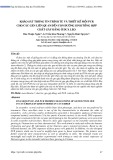
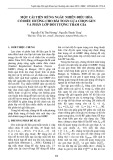
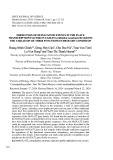
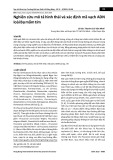
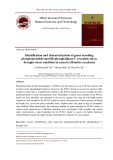




![Bài giảng Giáp xác chân mái chèo [mới nhất]](https://cdn.tailieu.vn/images/document/thumbnail/2025/20250927/lethihongthuy2402@gmail.com/135x160/92891759114976.jpg)



![Tài liệu học tập Chuyên đề tế bào [mới nhất]](https://cdn.tailieu.vn/images/document/thumbnail/2025/20250906/huutuan0/135x160/56151757299182.jpg)






